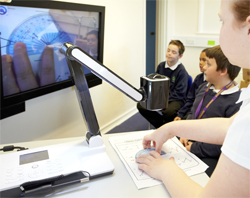- Show the class how to use small items. When teaching children how to use tools such as protractors and calculators, you can demonstrate on a large screen and even record your demonstration and leave it playing on a loop.
- Compare 2D and 3D objects and highlight how they differ. Many visualisers have split screens that allow you to compare and contrast all manner of objects.
- Explain how to construct charts and graphs. You can show exactly how to do this and which tools to use.
- Ask students to try to assemble a puzzle whilst the class watches.
- Practice sorting of shapes, numbers etc. Place a variety of 2D and 3D items on the visualiser and ask the children up to separate them out.
- Learn about symmetry. With a mirror image function you can explain about reflection, symmetry and angles.
Using visualisers to enrich the teaching of mathematical principles at key stages three and four:
- Ask pupils to demonstrate methods of calculation. Visualisers are a great way to get students really involved in the lesson.
- Model exam questions – write the answers down and work through with the whole class, or use a ‘conceal and reveal’ function.
- Demonstrate the use of logarithms and how to use tools such as slide rules.
- Explain theorums such as Pythageras and demonstrate how it is used in practice.
- Show the principles of trigonometry by demonstrating examples and working through formulae.
Whether you’re about to invest in visualisers, or already have one and are looking for new ways to use it, the above examples should help you to focus on using visualisers in your classrooms at key stages of a pupil’s journey in learning.
Of course, this list is not exhaustive and as educators you may discover new ways of using visualisers to enhance the teaching of numeracy. If so, please feel free to share your methods in the comments below.


















